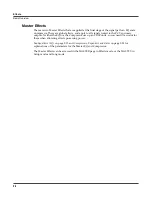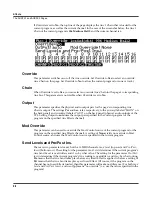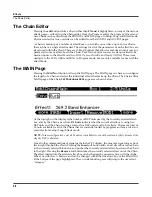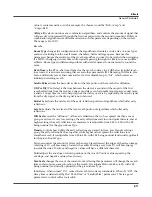
9-18
Effects
Filters
Dly Fine
adjusts the delay with a resolution down to 0.2 ms. Range is -20.0 to 20.0 ms.
Spacing
determines the starting pitch of the descending buzz and how fast it descends, by
setting the initial separation of impulses and the subsequent rate of increasing impulse
separation. The spacing between impulses is given in samples (20.8µs). At low values, the buzz
starts at high frequencies and drops slowly, while at high values the buzz starts at a lower pitch
and drops rapidly. Range is 0.0 to 40.0 samples, with a resolution of 0.2 sample.
Contour
controls the overall shape of the reverb. When set to a high value, sounds passed
through the reverb start at a high level, and it slowly decays. As the control value is reduced, it
takes more time for the effect to build up before decaying. At a value of around 34%, the reverb
behaves like a reverse reverb, building up to a hit. When it is set to zero, the algorithm acts like a
simple delay. Range is 0 to 100%.
Filters
There are four types of Resonant Filter algorithms in the PC3. All of them have these parameters
in common:
Filter Type
(or
FiltType
) can be Lowpass, Highpass, Bandpass, or Notch (band-cut).
Resonance
is the resonance of the filter, adjustable from 0 to 50 dB.
Resonant Filter
Frequency
(or
Freq
) is the fixed resonant frequency of the filter. Its range is 16 to 8372 Hz.
Envelope Filter
Envelope Filter is a resonant filter whose center frequency can be made to vary according to the
level of the incoming signal.
Filter Type
can be Lowpass, Highpass, Bandpass, or Notch (band-cut).
Min Freq
is the minimum resonant frequency of the filter, that is, the filter frequency when the
input gain is below the triggering threshold. Its range is 16 to 8372 Hz.
Sweep
determines how far the resonant frequency moves when the input level increases. At
positive levels it moves up in pitch, and at negative levels it moves down. The highest possible
resonant frequency is 8372 Hz, the lowest is 0 Hz. This parameter’s range is -100% to +100%.
Resonance
is the resonance of the filter, adjustable from 0 to 50 dB.
Atk Rate adjusts the upward slew of the attack portion of the envelope detector. Range is 0 to
300.0 dB/sec.
Rel Rate
adjusts the downward slew of the release portion. Range is 0 to 300.0 dB/sec.
Smooth Rate
slows down the envelope follower. If it is set to a lower rate than
Atk Rate
or
Rel
Rate
, it can dominate those parameters. Range is 0 to 300.0 dB/sec.
Triggered Filter
The Triggered Filter is a sweeping resonant filter that triggers when a certain input threshold is
reached, and then follows its
own
envelope, consisting of an instantaneous attack and an
exponential release, rather than the envelope of the input signal.
Содержание PC3
Страница 24: ...1 6 Introduction Options ...
Страница 50: ...4 4 The Operating Modes Using the Modes ...
Страница 174: ...7 54 Setup Mode The Utility Soft Buttons ...
Страница 178: ...8 4 Quick Access Mode Making Your Own QA Banks ...
Страница 204: ...9 26 Effects Mono Algorithms ...
Страница 266: ...A 2 MIDI Implementation Chart ...
Страница 308: ...Index x ...
















































